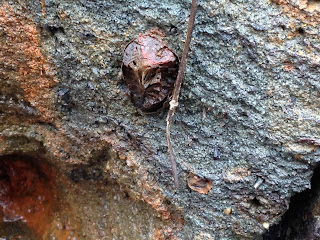Chasing Fossils and Pseudomorphs in NJ
 I was looking something up in Robert Bread’s
Rockhounding Pennsylvania and New Jersey book last night and came across the NJ map. There
isn’t much within my solo driving range of an hour, but I read anyway. Mullica Hill is
one of this sites I had been disregarding as boring rocks. Beard went to Mullica
Hill looking for Vivianite, a pretty blue mineral once the focus of attempts to
make blue paint. Unfortunately, it photodegrades to black. Beard’s photo was of
a black ring inside a hollow iron concretion. It didn’t excite me. However, he
mentioned that the vivianite formed around degraded fossils and that there were
reports of recognizable belemnites. So, I went out today to see what was lying
around. I can always enjoy finding pretty rocks.
I was looking something up in Robert Bread’s
Rockhounding Pennsylvania and New Jersey book last night and came across the NJ map. There
isn’t much within my solo driving range of an hour, but I read anyway. Mullica Hill is
one of this sites I had been disregarding as boring rocks. Beard went to Mullica
Hill looking for Vivianite, a pretty blue mineral once the focus of attempts to
make blue paint. Unfortunately, it photodegrades to black. Beard’s photo was of
a black ring inside a hollow iron concretion. It didn’t excite me. However, he
mentioned that the vivianite formed around degraded fossils and that there were
reports of recognizable belemnites. So, I went out today to see what was lying
around. I can always enjoy finding pretty rocks.The spot is a deep ravine right behind the municipal pool. There are signs facing the parking lot and also the creek indicating no trespassing, which I take to mean that they don’t want anyone messing around in the woods at the top of the hill. Getting up and down that hill is a two-handed project. Anything I carry out would have to be on my back.
The vivianite nodules are quite plentiful I found the knobby concretions strewn around the creek bed. They were mostly ringed in very dark blue to black inside rusty sandstone. They are filled with clays of green and yellow.
 |
| Belemnite? The world will never know! |
The steep banks are mostly brown, but here and there have multicolored clays. One such spot appeared to have a belemnite phragmocone sticking out, but when I touched it, it crumbled like clay. I’ll never know for certain, but it like very much like a belemnite in the picture, too.
 |
| Vivianite tube with a badly-degenerated belemnite fossil inside |
Further along, I found a recognizable belemnite bit, as well as a couple of very badly broken and stained oyster shell bits. Some of the belemnites, unsurprisingly, had sand fused to them – the beginnings of concretions. From this I realized that many, if not all, of the rod-shaped concretions were originally belemnites. This was confirmed when I got home and found images online labeled “vivianite after belemnite.” Ha!
 |
| Along the banks of the Raccoon Creek, Mullica Hill, NJ |
I also noticed something that looked like coal here and there. At first, with all the junk, I figured that it was artifact from someone’s coal furnace. Further down the creek I found some that looked suspiciously like wood. It’s too solid for lignite, but may be some form of pet wood further along its way to jet and coal. It might also be a mineral called rockbridgeite, which occurs in massive form here. I haven’t found anything definitive about it online yet.
I'll have to visit again in the warmer months when I can wade in the creek without freezing my toes, and perhaps bring with me a better understanding of what I am looking at as I go.
 |
| Fossil oyster shell, probably Pycnodonte sp. |
 |
| partial Cretaceous Belemnites phragmocone |
 |
| Petrified wood of some kind? Abiotic mineral? Still trying to figure this one out! |


Comments
Post a Comment